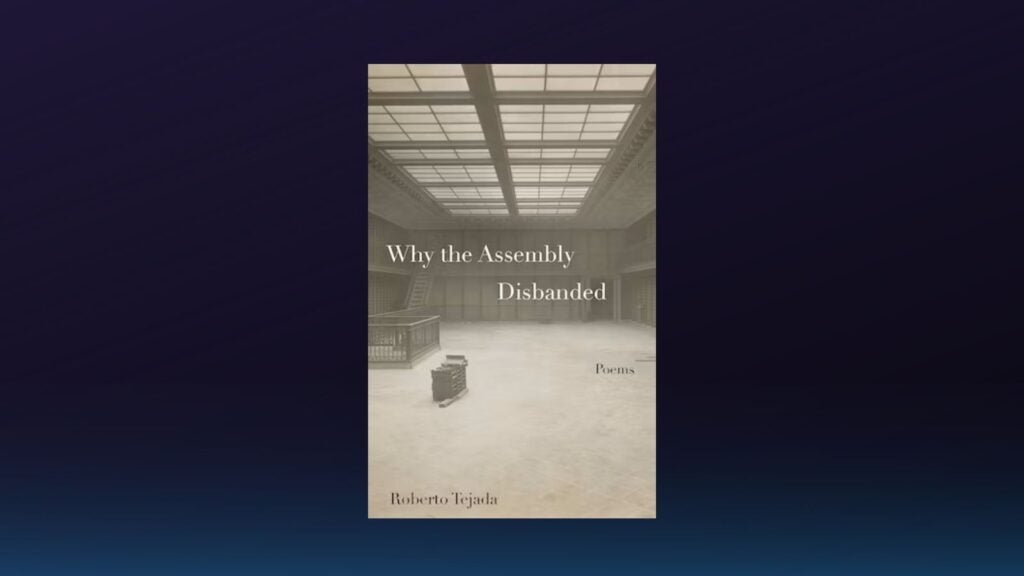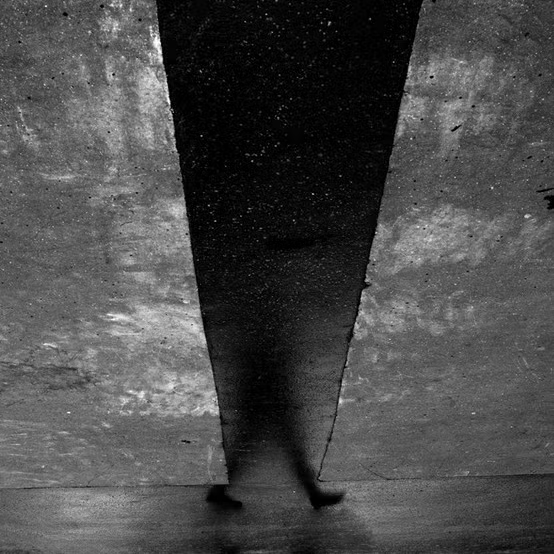Assemblage is a danger. Artists, poets, immigrants, outsiders, and insiders—to gather is to think, to subsist off bounce-backed ideas, language, identity. To assemble is to resist abidance. To birth that which is new, to resist, to polish that which is worn-out. Why the Assembly Disbanded by Roberto Tejada endeavors to assemble the heart of assemblages; it fights to illustrate the power struggle built in the plinths of assemblage, the borderlines that break it, and the often-quiet forces that attempt to wrench power from the individual and collective.
The collection kicks off by throwing the reader into the midst of this struggle with the poem “Two Guardians”—immediately, the speaker’s “words were sent underground to where the toggle switch detonates.” We’re in the subterranean, drowning in the air of restriction and industrial oppression: “the arrows leading there facilitated those // of us in line as though reliant on east and west quadrants.” A mass of the “common man” is here, blindly following “a fanfare.” The speaker is confused, lost too, wondering why they were “sent to the nether / world inflicted with no wound.” Confusion serves as the volta for this poem—the tyrannical, straightforward language and almost grating line-breaks ignite into a hodge-podge of sounds and sentences with wild cutoffs of last-gasp thought as the touch of the human wishes to flare-up:
Someone lets fall a pair of ziplocks containing the crystal bliss of conspiracy; what I had to say was sent, I mentioned this I think already, underground switch and toggle intended to ignite what I could never bring myself to mean. Where the voices were avoiding me—hands outstretched at quarter day to hold back the beam—was there something broken?
The human, in this poem, finds themselves lost—a cog in a coarse borderline breaching worlds—but they feel the cracks of their skin; the wild runs of their mind, searching for a stolen voice; and their heart, by proxy, needs to fight: “I weather compliant,” Tejada writes. “I rally.”
Energy is hard to sustain, though. All strains of counterculture must rise above that which they counter. A tired anxiety pervades the collection—of assimilation and the seemingly never-ending war with it. “Why Fear Heights,” for example, hones in on the countdown of impending fear: “Now phonic, now / phosphorescent whether fourscore and seven // to estimate the next great task remaining.” Associations (in this case, deeply American and deeply racial) have strayed in meaning, as has the idea of America (obscured since its inception); line breaks jar language into separation—sometimes witty, sometimes sonically resonant, and always self-aware—broken off like “property subject to seizure.” In “American Household,” we are vagrant, but the language doesn’t let us stop moving through the haze of consumption; Tejada’s rapid-fire eyes detail the American household: “Of corporation unnerving / All restraint from the madness or immodesty that coils / Each milligram back into the blue sky oxy addiction.” This American marketplace is manufactured “for the painless end-to-end encryption’s,” a marketplace entrenched in every inch of American life. Punctuation doesn’t let us stop for a moment, not one end-stop or period of rest, as if we’re caught in a “Line and still the others keep cutting ahead of us here.” Often these sentences, phrases, or lines, feel like lost vignettes or ideas excised from the rest of the assembly—self-serving, individually-minded piths—evoking the so-called “American Dream” that has only succeeded in artifice and division; the dream that enlists voices to anger, or “turns us into tyrants unspeaking”; a dream “lawless for us depraved and still deprived of power.”
The idea of America itself is strange, fraught with conflict, confusion. Sometimes the speaker sits on American borderlines—the pitiless, near-dystopian worlds that kill. In “Or Why the Assembly Disbanded as Before,” automaton-like nurses labor “in green-grey subterfuge, in all-over stripes.” Tejada mechanically plods from image to image, steps through gun fields, rounds of punches, trademarked drugs, tray tables mechanically upright, superstores, and tattoo shops. Throughout the whole of the first section, “Society of Alternate Belonging,” the sense of an impenetrable tyranny—a too-uniform modus of humanity—is cranked away in vague communes. The poem is largely only hyper-specific when recalling brand-named consumer products, as if they are the sole procedure of consciousness.
The next section, “Amend, Delay, Curve, and Disquiet,” seeks to fight the body of U.S.-centric imposition that casts a shadow over borderlands, America, and itself. It is a mishmash of photography almost arranged in poetic syntax, juxtaposed with text-based poems themselves. The poem “Baraka Inscape” leads the section (before the assemblage of photographs), almost a preamble. It has a desolate language, bone-weary line breaks and repetition. The speaker feels lost in the clutch of post-colonial depravation, a vacancy of identity and culture: “Not so for my republic nothing left of rule / Nothing left of rule over the savage self.” However, as the poem trudges on, it finds a quiet passion in a white-laden world, the “Still wreckage a resource like flesh.” It finds the “advent of mind in the kinfolk,” in the “land-locked earth in antipodes // in eyes-wide noncombatant number / in clay and kiln, in day and bone.” It pinpoints the joints of the human so stripped of their identity, and, in quoting the always-fighting tongue of liberationist Amiri Baraka, nominates the succeeding photographs as essential to syncretism and uprising within words, and worlds: “in name an ‘eruption of counterform / in the closed field of white definition’.”
The photos are intense. They’re dominated by a few of analogous or (roughly) monochromatic coloration, gut-wrenching and muddling in their over-the-top saturation. The first four photos are by Rubén Ortiz Torres, a multimedia artist sprung-up in the L.A. Chicano and punk scenes (much like Tejada himself). His work reflects on globalization, consumer culture, and the idea of “Western” hegemony automating and othering while simultaneously enamoring themselves in the artificiality of these “others.” The included photos have the glare of salt, cyanotype, gelatin, platinum, the digital. For example, the photo Apocalypto, taken in San Jose, features a shopping center of sorts in the shape of a Pre-Columbian monument; though it was taken in 2007, it almost looks as if it was taken haphazardly, as if with a handheld phone, as if it were a tourist’s snapshot. There are run-of-the-mill people about their day, shopping carts, a string of cars, and the backdrop of the “monument,” all cast in a red that gnaws and a digital front that gives no preference, in terms of focus, to the people, the cars, or the shopping-monument. His following photos—“Heret-Kav She Who Is Above the Spirits,” “Los indios de Barcelona” (both taken in Spain), and “Un poco de su país”—are of a similar nature, monochromatic, starkly contrasted and featuring bungee-jumping, sightseeing Spanish whites (or The Indians of Barcelona, as the title puts it) fraternizing, and a lone cowboy-hat-wearing man pushing a shopping cart. All are garnished with the backdrop, as if globalized consumer-culture has attempted to put their colonial ills and frills behind them, of Pre-Columbian monuments, architecture, arts, and ideas, sometimes juxtaposed with tawdry signage or electronics store ads.
In choosing the photos, Tejada curated the speculative, otherworldly eye of the world we’re so used to, so as to derealize the world we’ve been forced to accept. Connie Samaras’ work, which follows Torres’, is part of a collection called “Edge of Twilight”; it features photos of run-of-the-mill suburbia, but with alien overtones that feel off. Then, after Samaras’ work, in what feels almost like a poetic volta, we see photos from NASA and ESA repositories, which zero-in on the otherworldly but zero-out for a broader juxtaposition—a tapestry of lightning, the moon, and the jagged-rock skin of a comet. Following them, surrealist-era photographer Raoul Ubac and Tom Zimmerman display black-and-white lands that, though taking place indoors, feel as otherworldly as the moon photos that preceded them. Interchanges and bare hideaways cast a barren, uncanny feel over the whole of the photos, and in the context of the collection, ask us who the aliens of these lands really are.
The last section is “Kill Time Objective.” The poems within are as inconclusive as the title: poems end with no end-stopped lines; language is chopped up in fragments, almost flashbacks, of the history that preceded their existence. The poem “Color Wheel | High Water” stretches to the self-reflexive, again with vagrant objects and individuals that circumvent imperial taxonomy: “Neither memoir nor manifesto, and having a surface rough to choppy / intoxicated currents of coerced conformity; blue star casing, damage // without redress of law; liquids that concilliated sleep.” Throughout the collection, Tejada hints at language, plays and spins the commonplace patois that dictates how we communicate. It almost feels that with each fragment, we’re closing-in on a concrete inch of language, but the more we dig, the more it feels like an assemblage of individuals, an undefined mass, wandering, each fragment nearly alive, but cut before bound to reality:
when banners line the avenues as circumstance turns promise possible loud heart and holy smoke made moan for us all the thunderstruck pine and eucalyptus chitter of finches taciturn token hope a color wheel daubed with slopped liquid and lacking formal cause, fastidious
The poem ends without definition, on ledges of line breaks and the echoes of sounds the collection has collected throughout, a repository of familiar-seeming but never-sated desperation—it lies on the face of language, the confusion that hangs from centuries of manipulation.
But there is a self here. There is someone. They slip in and out of the poems, they’re an emblem, they’re an assembly. But as the collection progresses, we feel like there is an individual bunched in with others. In the title poem “Kill Time Objective,” there is a first-person laying claim on an “acoustic self,” their claim fought “by militia,” a “mouth emission” that fights to keep them a “third person plural,” unidentified and dehumanized save for glimpses of humanity. They’re compelled to complicity, conformity, the borderland of personhood that is remaining a veritable “alien” yet even without resisting assimilation. The speaker will fight, though: the speaker notes that “complicity was to the frenzy of flesh, muddle of tongues, a ransom note,” punctuation omitted in the speed of a consciousness losing breaths of relief to conformity. It knows
for the sake of fighting for breath already the instrument for transposition in a parasitic image finally proper to this place: I’m the encryption I’m the statistic, no longer bristing in the heroics of metaphor, I’m equipped with artillery that enables me now to bullet an opening for everyone’s deliverance.
Still, conformity does not let anyone off easy—it’s a power struggle, an inevitable one, a process detailed like the bleak, confrontational but quiet actor that it is: “but for the conference hour this week with my parishioners in exchange for the motion in multiple layers—overcoat, many trousers, uniform—in the process of my ballooning self into unprecedented scales of subjection.” As the speaker slips into a comatose haze, the blur of mashed-up individuality that renders the person third-person, they fall into their “molecular resemblance.” They mold, and are molded—they ask, “now children please open to lesson thirty-two.”
In the next poem, however—“Liquid M”—an assembly emerges from the “radio haze of association,” from the “teeming number of persons to a person” to a life accentuated by the voice of a mass rather than obscured by it. The voice is loud, but confused—it watches over “each face suddenly half-obscured by this lectern / Serving as my foreign shell.” Inside assemblages and out, there has “appeared a physical but weirdly porous / Boundary.”
Yes, assemblages are strange. They can be used to gather, to rally, but so too can they be used to lump together lives and eclipse the individual. The poem “Vanishing” is roiled in this confusion, the double life “conjured by vocables from a zone of repetition,” a place of “all things / abrupt now intermittent.” The voice of the speaker, the poet, grapples with claims of the self as surfacing from assemblages: “Discrete words a partial view, but even as I surface—subject to predicate, at best a proposition, belated reason ‘I’ am the cause of my thoughts.” Their life is “a social statistic”; still, the speaker fights, the speaker wins:
untangle the strict partitions without hazard to the shell protective of all persons provisional in settings that reflect, I cover ground, I quicken, I substitute the vanishing with constituent parts, regenerate, deprived of a halo, released from this fixity, am I not without radiance of my convenient forgetting and, everyday—because it so beckons—in the recurring custody of a world, around whose mindfulness we congregate, and over which we are inclined to argue?
And in the last poem, “Envío,” Tejada spells out—to himself, to all assemblages and individuals—a fighting answer, a story of survival from the hard-wrought anatomy of neighbors, borders, and the oppressed designs of the psyche:
without shade or reciprocity of pattern forward-hover slant into the upper-zones but at no apparent endpoint or clef do I cease in soft desist






